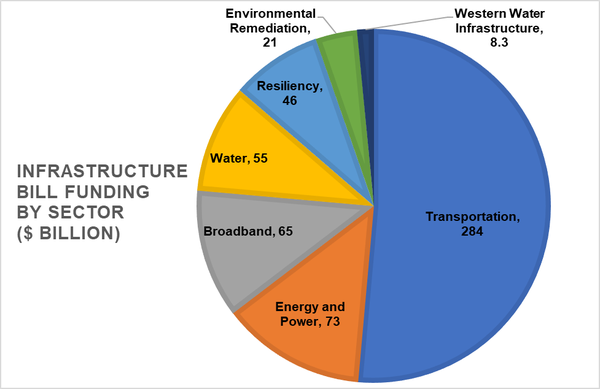President Biden recently signed the historic $1.2 trillion Infrastructure Investment and Jobs Act (IIJA) into law as a part of the Build Back Better (BBB) framework. The IIJA will be the nation’s largest investment in infrastructure constructions, renovations, and innovations. As such, the IIJA includes several provisions that have major implications for the forestry agencies and communities including the forest product industry and landowners. In this note, we explored the key provisions and funding allocations affecting forestry, wildfire management, and workforce development.
The legislation is scheduled to be primarily funded utilizing unused appropriations from COVID-19 relief measures. The IIJA is set to provide over $550 billion from FY 2022 through FY 2026 in new investments to the following sectors:

Infrastructure bill funding by sector.
Source: naco.org
Table 1 below summarizes some of the key provisions related to forestry.
| Sector |
Provisions Affecting Forestry |
| Transportation
|
- Weight limits of state roads that are set to become interstate highways remain at 90,000 pounds as opposed to decreasing to 80,000 pounds.
- Enhancements to workforce development to encourage creation of new educational programs for workers in the transportation sector. Similarly, a pilot program to allow drivers of 21 years of age or less to operate trucks across states following training. This could be beneficial for loggers and timber haulers.
|
| Forestry and forest product industry
|
- Federal subsidy system for sawmills and wood processing facilities, including $400 million in financial assistance, that would consider proximity to sawmills when funding federal land restoration projects.
- The Repairing Existing Public Land by Adding Necessary Trees (REPLANT) Act will increase reforestation investment four-fold on national forestlands to support the USDA Forest Service in planting 1.2 billion trees, creating almost 49,000 jobs over the next 10 years.
- $200 million appropriated to reforest abandoned mine land and additional $200 million aligned for funding the country’s national seed/seedling strategy.
- $490 million to fund natural infrastructure resilience through urban forest management and tree planting.
- Creation of the Healthy Streets program to provide grants to governments to expand tree cover and deploy cool, porous pavements ($100 million each fiscal year from 2022 to 2026).
- $1.5 billion for state and private forestry (wildfire risk reduction and ecosystem restoration)
|
| Wildland Fire
|
- $3.3 billion designated for wildland fire issues including the creation of the federal Wildland Firefighter occupational series, which also increases the salary of wildland firefighters employed by federal agencies, and management of personnel to increase the number of full-time wildland firefighters and improve the health and safety of members of the workforce. Funding has also been designated for fire science research and communication, as well as land management practices such as prescribed fires, construction of fuel breaks, and thinning/removal operations and programs to aid communities and tribal nations with forest restoration. For instance, $20 million is specifically allocated for the Joint Fire Science Program to fund fire science research.
|
| Manufacturing
|
- $2.1 billion for improvements, with specific provisions for small- and medium-scale operations, in energy, water, and material efficiency, waste reduction, pollution control, and load management without decreasing net returns. More specifically, the Office of Energy Efficiency and Renewable Energy will perform onsite technical assessments to identify opportunities for manufacturers to conserve natural resources and expand their usage of sustainable materials, potentially reducing pressure on the Nation’s forests and creating new markets for sustainable products.
|
For more information on the IIJA, please visit the official bill (H.R.3684 - Infrastructure Investment and Jobs Act).
Other References
Daley J. 2021, November 5. Celebrating the infrastructure bill – A win for America’s forests. American Forests.
Forest2Market. 2021, November 9. House Passes $1.2 Trillion Infrastructure Bill; What’s in it for Forestry? Forest2Market.
Gabbert B. 2021, November 6. Congress appropriates $3.3 billion for wildland fire. Wildfire Today.
National Association of Counties [NACo]. 2021, November 7. Legislative Analysis for Counties: The Infrastructure Investment and Jobs Act. NACo.
Publication date: Nov. 22, 2021
N.C. Cooperative Extension prohibits discrimination and harassment regardless of age, color, disability, family and marital status, gender identity, national origin, political beliefs, race, religion, sex (including pregnancy), sexual orientation and veteran status.

